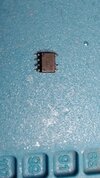Martaine2005
- May 12, 2015
- 4,963
- Joined
- May 12, 2015
- Messages
- 4,963
There will be one or possibly two components shorted.
Finding them is usually quite straightforward given the symptoms. Your ability or inability to fault find is important here.
Finding them is usually quite straightforward given the symptoms. Your ability or inability to fault find is important here.

